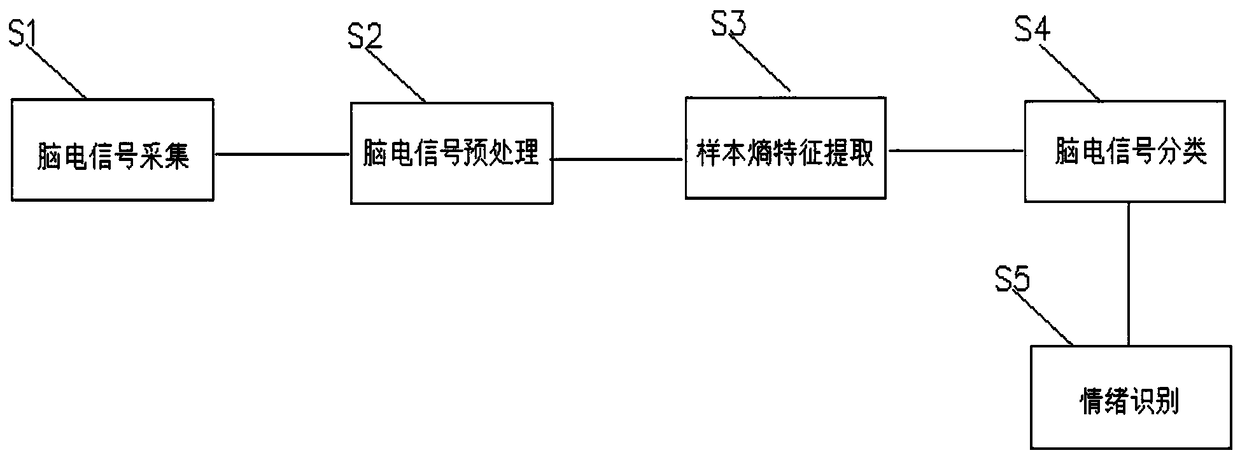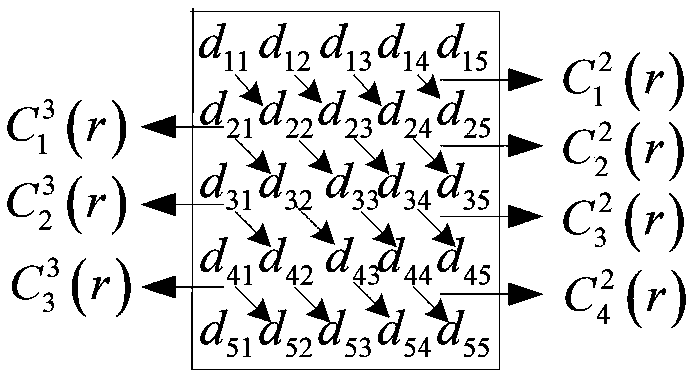Human body emotion recognizing method based on real-time electroencephalography
An emotion recognition and EEG technology, applied in medical science, psychological devices, sensors, etc., can solve the problems of inability to comprehensively, effectively and accurately identify EEG signals, unable to meet the needs of work and life, and complex EEG signals. The method is simple, improve work efficiency, and identify comprehensive and accurate effects
- Summary
- Abstract
- Description
- Claims
- Application Information
AI Technical Summary
Problems solved by technology
Method used
Image
Examples
Embodiment 1
[0043] see figure 1 , the human emotion recognition method based on real-time EEG, comprising the following steps:
[0044] Step 1) EEG signal acquisition S1: including collecting the subject's EEG signal by using a multi-channel EEG acquisition device;
[0045] Step 2) EEG signal preprocessing S2: Preprocessing the EEG signal obtained in step 1 to reduce trail interference and improve the final classification recognition rate;
[0046] Step 3) extracting S3 features of the EEG signal sample;
[0047] Step 4) classification S4 of EEG signals;
[0048] Step 5) Carry out emotion recognition S5.
[0049] Said step 3) extracting the features of the EEG samples includes extracting the features of the EEG samples through the sample entropy algorithm; said sample entropy algorithm is specifically obtained by the following algorithm formula:
[0050] Let the original data be a time series of length N, expressed as: {u(i):1≤i≤N};
[0051] 3) Construct a set of vectors X(1), X(2),......
Embodiment 2
[0067] The difference with the foregoing embodiment is that in this embodiment, the step 3) extracting the feature of the EEG signal sample also includes extracting the feature of the EEG signal sample through the binary distance matrix sample entropy algorithm; The distance matrix sample entropy algorithm is specifically obtained through the following algorithm formula:
[0068] Step 1: For the N-point sequence, first calculate the N×N binary distance matrix D=[d ij ] N×N .
[0069]
[0070] In the second step, using the elements in the matrix D, according to the increasing order of rows, the matrix elements of every two rows (when m=2) or every three rows (when m=3) are combined according to the direction of the oblique line "and " operation, add up the result of the slash "AND" of each line and divide it by N-(m+1), you can get and
[0071] Such as figure 2 Shown:
[0072]
[0073]
[0074] For example, when m=2, we need to judge whether d[X(2), X(4)24 *d...
Embodiment 3
[0078] see figure 1 , the difference from the above-mentioned embodiment is that in this embodiment, the step 4) classifying the EEG signals includes a support vector machine classification method and a genetic algorithm classification method.
[0079] The support vector machine is a new machine learning method developed by Vapnik on the basis of statistical learning theory. It is based on the principle of structural risk minimization, which ensures that the learning machine has good generalization ability. , high-dimensional, nonlinear, local minimum and other problems are better. The least squares support vector machine is a new type of support vector machine proposed by Suykens et al. It incorporates the least squares linear method into the support vector machine, and transforms the quadratic programming problem in the standard support vector machine into Linear equations are solved, thus simplifying the computational complexity.
[0080] The genetic algorithm classifies ...
PUM
 Login to View More
Login to View More Abstract
Description
Claims
Application Information
 Login to View More
Login to View More - R&D
- Intellectual Property
- Life Sciences
- Materials
- Tech Scout
- Unparalleled Data Quality
- Higher Quality Content
- 60% Fewer Hallucinations
Browse by: Latest US Patents, China's latest patents, Technical Efficacy Thesaurus, Application Domain, Technology Topic, Popular Technical Reports.
© 2025 PatSnap. All rights reserved.Legal|Privacy policy|Modern Slavery Act Transparency Statement|Sitemap|About US| Contact US: help@patsnap.com



